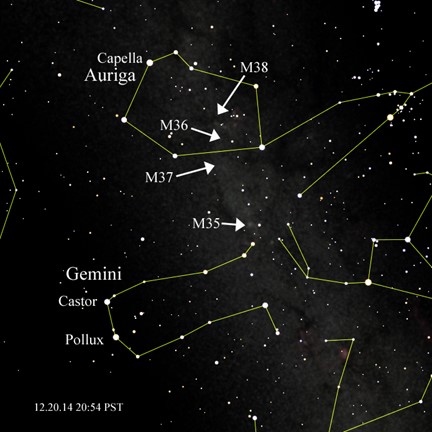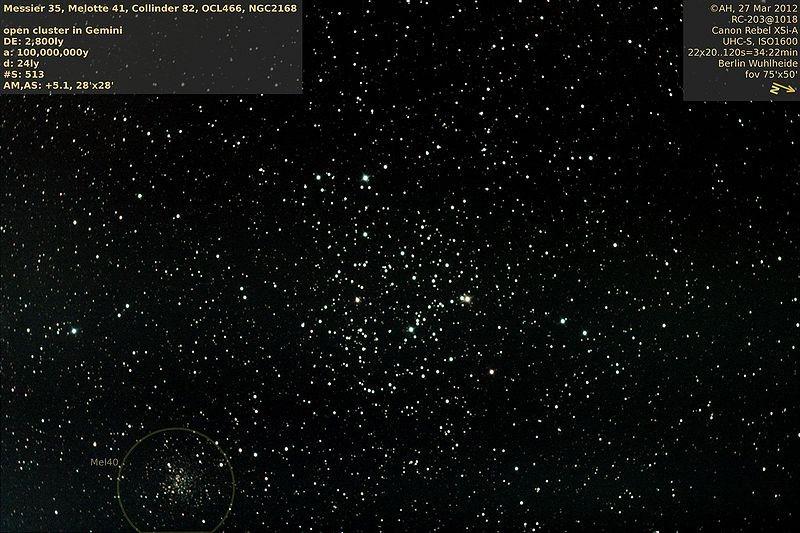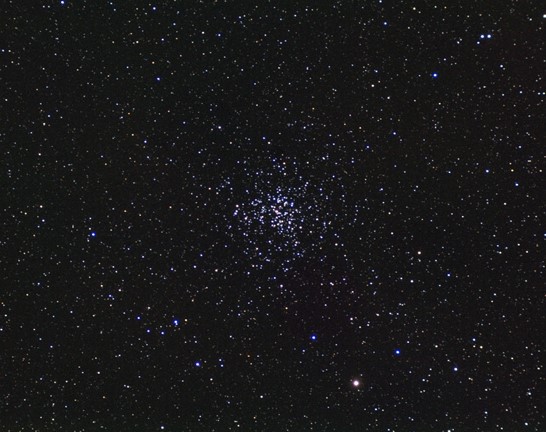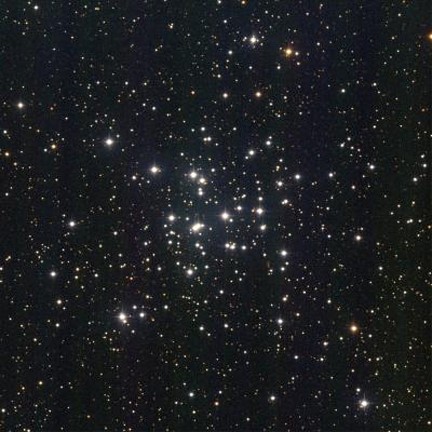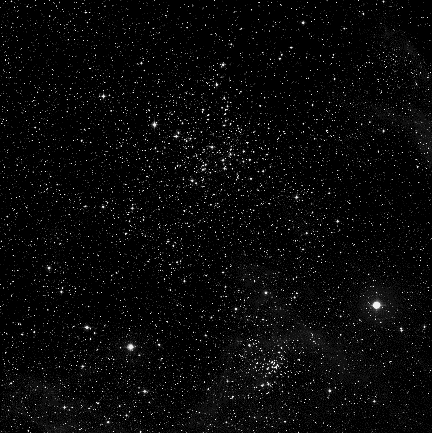
One of the nicest aspects of winter observing is the early sunsets and long nights. You can be outside and enjoy an hour or so of astronomy, and still be in early enough that mid-week viewing is an easy habit to acquire. All we need are clear skies. When you have them, get out and enjoy!
I find nothing more pleasing than an easy star hop from one great target to another. Take your binoculars or telescope out this week for a short but fun hop to four big and bright open clusters full of variety, as well as some interesting challenges. These are clusters that will become staples of your winter observing routine.
Find Gemini and Auriga rising above the eastern horizon in the early evening. M35 (discovered by Philippe Loys de Chéseaux) is the lone Messier object in Gemini. The trio of M36, M37 and M38 form a nearly straight line, equally spaced in Auriga. Charles Messier discovered them while searching for comets from his observatory in Paris, France. He discovered 16 comets, but is more famous for objects he cataloged as "not" comets, so he wouldn't mistake them in his search. The list of non-comets became famous at the Messier Catalogue, 110 objects that represent the brightest and arguably most interesting deep sky targets in the northern skies.
Let's begin with M35 in Gemini. It is very easy to locate off of one of the Twin's feet. Train your binocular or telescope finder on Eta Geminorum - the last star in the chain that begins with Castor. You should see the big open cluster as a bright fuzzy patch of light to the star's north-northwest. At magnitude 5.1, it is quite bright, so much so that there are reports of observing it without optical aid, meaning, naked-eye. Try this from a dark sky. In small binoculars, such as a 7x35, it appears as a 25' fuzzy patch with hints of resolution in periods of excellent seeing. In an 8" telescope it is best viewed at low power, so the cluster does not entirely fill the field of view. One description has it as somewhat donut shaped, with fewer stars in the center. The cluster is about the size of the Full Moon, has at least 120 stars of magnitude 13 or brighter, and is at a distance of 2800 light years. Do you see a dim unresolved glow 15 arcminutes to the big cluster's southwest? That's another open cluster, NGC 2158, 10 times older and five times more distant! NGC 2158 is a nice treat coupled with M35!
Use the finder chart at the start of this article to hop up from M35 toward Auriga, between its two closest stars, but stay on the M35 side. Your finder or binocular should show what most observers consider to be the prettiest open cluster, M37.
M37 was discovered before 1654 by Italian astronomer Giovanni Battista Hodierna. The brightest of the three Messiers in Auriga, it is a very evenly distributed open cluster, with hundreds of stars of similar magnitude. The cluster has over 150 stars brighter than magnitude 12.5. It lies 4500 light years from us, and, with an overall magnitude of 6.2, it has been seen naked-eye. One observer has seen it in 8x21 binoculars from skies limited to magnitude 3. That's quite an accomplishment, but you should use larger binoculars or a telescope to enjoy the cluster at its best. Here is a nice description by Michael Geldorp using an 8" f/6:
"Magnificent cluster. Large and very rich cluster. The stars in M37 seem to form streams flowing outward from the center and there appears to be a relatively starless area near the center. Unbelievable sight at 98X with the cluster more than filling the field of view. There is a yellowish/orange bright star near the middle of M37."
Move just across the constellation line now, to M36, and you'll see a dramatic difference in appearance compared to M37.
M36 will appear smaller, and sparse by comparison. It too was discovered by Hodiema. It shines at magnitude 6.3 and is 4,100 light years from us. Its size, though, is half that of M37. The difference will be very apparent. It has been reported as a threshold object naked-eye. Try for it that way from your darkest skies. In 7x35 binoculars, observer Lew Gramer reports: "This open cluster under these skies showed as a mere 15' irregular fuzzy patch NE of a pretty grouping of seven mag 5-8 stars, all lined up along a 2-degree path roughly North/South." Michael Geldorp in his 8" f/6 reports: "Nice bright cluster with streams of stars that give it the appearance of a crab to me. Less impressive than M 37, this cluster has fewer stars but more relatively bright ones. Located in a rich part of the sky."
The last of our clusters is M38, which is reminiscent of M35 in that it has a smaller open cluster paired in the field of view.
M38 is listed at magnitude 7.4, so the few "visual" observations (naked-eye) I've found are beyond the reach of most normal humans, but there are reports. In fact, one report says all four of these Messiers are visible at the same time, in one view, from a very dark (magnitude 6.7) location. I'll have to try it. What I do find reliable and interesting is the excellent observation by Michael Geldorp (again): "Large and rich cluster best seen at 49X. Not as many bright stars as M36 but richer in fainter stars. There is a conspicuous Y shaped asterism in the central part of M38. 98X showed more stars but the grandness of the cluster is lost with high powers. Striking contrast with nearby NGC 1907, reminiscent of the M35-NGC 2158 pair. 60-70 stars seen at 98X."
The cluster was also first observed prior to 1654 by the Italian Hodierna. Its 4,200 light years away and is nearly as large as M37 at 24 arcminutes. Unlike NGC 2158 near M35 thought, NGC 1907 is the same distance from us as M38.
All four Messier open clusters are around 4,200 light years distant. To give you an idea of what these clusters' distances mean, if we were to view the sun from within M38, it would appear as a magnitude 15.3 star. Go search for one in your telescope. Here's another fun fact, and chuckle — none of these four Messiers was actually discovered by Charles Messier!
I hope you've enjoyed this "hop". There are lots more, clusters, bits and pieces of nebulae strewn through our nearby home locale, and strings and chains of galaxies to explore.
Till next time under the stars,
Mark Wagner
Mark Wagner is a life-long astronomy enthusiast and deep sky observer. He has spent the past twenty years popularizing amateur astronomy in the San Francisco bay area through his writing and community building. A past president of the San Jose Astronomical Association, he founded what is now the annual Golden State Star Party in California. Leave your comments or questions for Mark Wagner in the comments section below, and submit your sketches or images of the targets mentioned to the Orion Image Gallery.




